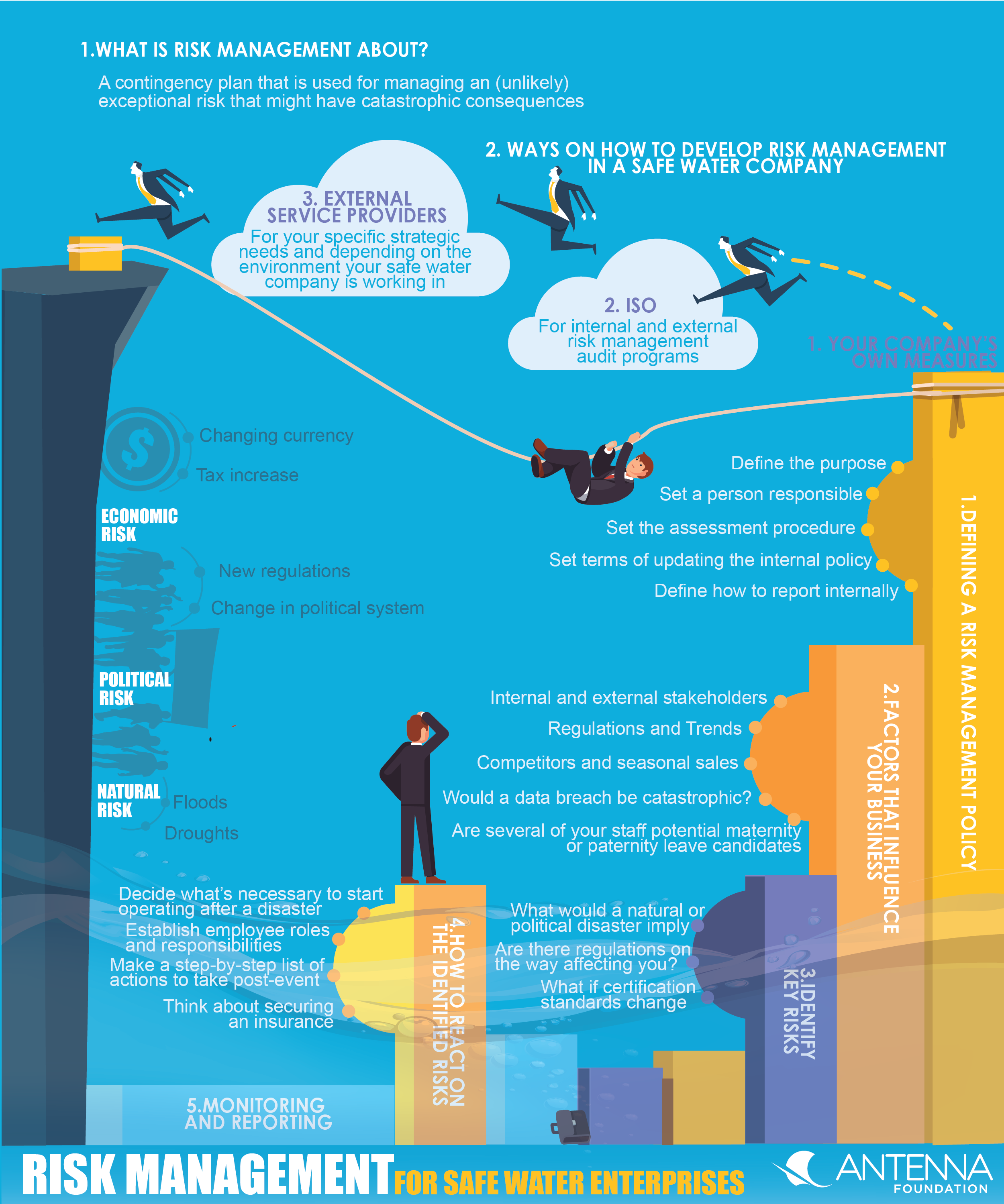Executive Summary

Risk management and contingency planning help your safe water enterprise to identify and prioritise risks, plan and prepare counteractions for incidents that jeopardise a company’s existence now and in the future. Risk management is relevant not only for safe water businesses but also for governments and investors. This factsheet is specifically lined out towards safe water enterprises, permits though to inspire others develop and improve their risk management.
Spring Health's case study offers insights of how a water kiosk business deals with its external risks and shows how its contingency planning has been developed.
The case study on TARA shows how a company has identified, assessed and planned to mitigate potential risks within its chlorine production.
What is risk management about?
Risk management identifies and assesses potential internal and external risks (financial, environmental, political etc.) that can occur and jeopardise a company. Based on an assessment of these risks, a plan can be developed to prepare for and mitigate such eventualities in practice. Such a plan is often referred to as contingency plan and used for managing an (unlikely) exceptional risk that might have catastrophic consequences for a company and plans accordingly for actions to mitigate and/or react on such occurrences. Examples can be political risks (change in political system, new regulations etc.), economic risks (tax increase, corruption within the company, changing currency, etc.) natural risks (floods, droughts etc.) (DEVELOPMENT COOPERATION OF DENMARK, 2017; WILEY ET AL., 2012).
Why is risk management needed?
A business plan that only considers the best-case scenario of a safe water start-up or initiative isn't likely to last long. Anticipating potential risks of a company, including seasonal drops in revenue or new competitor products entering the market for instance, is crucial to ensure an overall business strategy that is prepared for eventualities. The more risks a business can anticipate, the better a company is prepared meeting the many challenges that can arise for a relatively small business especially in the safe water sector.
For whom is risk management interesting and useful?
Managing risks is a must for any safe water enterprise, as many market uncertainties are in place. Having a plan for counteracting them allows safe water enterprises to handle abrupt market changes and better adapt to it by preparing the managerial team in advance.
Contingency planning for larger businesses generally deals with unexpected events that affect the financial health, professional image, or market share of the company – issues like supplier disruptions, legal cases or simply large unexpected orders that a company might be struggling to produce and deliver due to capacity restrictions for instance. Though large firms have bank accounts that, combined with a solid contingency plan, facilitate quick recovery if problems occur.
Business owners may face even more market uncertainties and need to prepare for the very same events too (BRINCKMANN ET AL., 2010). In the case of safe water businesses, this is no different: unreliable suppliers, impact of climate change (such as droughts or floods), or governmental actions are non-exhaustive risks on the list. Yet, how can smaller businesses create similar contingency plans as large firms – with limited financial resources?
How to develop your company’s risk management in practice?
Contingency planning and risk management are only as good as the strategies developed to help mitigate the potential damage (financial, reputation etc.) caused. A solid contingency plan will not only measure the various risks and threats that may emerge, but especially the measures that would be taken by the firm in order to address them, as situations occur or to mitigate the risks of occurrence.
There are different ways on developing your company’s own risk management:
- The International Organization for Standardisation (ISO) has published the ISO 31000 risk management standard that provides guidance for internal and external risk management audit programs. This standard allows comparing a business’ risk management practice with an internationally recognised benchmark to risk management. (ISO, 2018)
- Different service providers are specialised in the creation of a risk management shaped for your specific strategic needs and depending on the environment your safe water company is working in. You can find such companies on the internet or by asking your local chamber of commerce.
- Last but not least can your company develop a variety of measures for managing risks itself. Such measures are presented subsequently.
Developing your company’s own risk management
There are several steps a safe water enterprise has to pursue in order to come up with a risk management concept concerning the 4 risk-segments environmental, social, economic and political (SHENKIR & WALKER, 2007) These steps are:
- Define a risk management policy
- Identify and categorize what factors influence your small business (VIDAL, 2015)
- Assess and define the risks affecting you
- Plan your risk response actions
- Risk Monitoring, Controlling and Report
How this 5-step process will look like and what aspects your risk management will cover depends on the needs and budget your company has. Risk management has a cost that can either be paid internally or covered externally as part of a blended finance scheme (e.g. a partner is de-risking the investment trough paying the development of a consistent risk management). In order to come up with a feasible risk management strategy follow the subsequent 5 steps (INSTITUTE OF RISK MANAGEMENT, 2002):
1. Define a risk management policy
A risk management policy establishes the direction and informs and guides the way in which internal and external risks are managed within your company:
- Define the purpose of your risk management (shall there be a focus more on external risks (environmental, market, politics etc.) or internal risks (finance, employee turnover, accidents, fire…))
- Set a person responsible and accountable for your risk management
- Set the procedure how risk management shall be assessed
- Set terms of updating the policy
- How risk management will be reported
2. Identify and categorize what factors influence your small business (VIDAL, 2015)
Identify how internal and external factors of your company’s environment affect your business activities (economic, environmental, societal, and political):
- Reflect about internal and external stakeholders and their influence on the company
- What are essential factors to keep your company operate successfully?
- What trends could affect your business? (positive and negative)
- Could regulations hamper your business?
- Are there seasonal sales?
- Are there competitors pushing into the market?
- Is drought an issue where you are?
- Would a data breach be catastrophic?
- Are several of your staff potential maternity or paternity leave candidates?
These are all issues safe water business owners should reflect and be prepared for eventually.
Tools/ ways to identify risks are for example:
- Brainstorming in your team
- SWOT-Analysis
- Risk surveys
- Interviews with employers, suppliers, experts, etc.
- Focus groups
3. Assess and define the risks affecting you
Prioritise (probability of occurrence - likelihood and affection) the identified risks and write down how they are potentially affecting your company.
Potential questions to be asked:
- What would a natural disaster imply?
- Are there regulations on the way affecting you? (Regulations on water standards, HWTS, business regulations – (see tool laws, policies and regulations for more information)
- What if certification standards change?
- What might a political change imply?
Tools for assessment and prioritising:
Accordingly you have a list of risks rated as per its probability of occurrence.
4. Plan your risk response actions
Reflect on how to avoid, mitigate and deal with the occurrence of the risks:
- Pinpoint operation essentials: Decide what’s absolutely necessary for your small business to start operating again if a disaster or illness forced you to close. Then take steps to ensure that those resources are available quickly if needed.
- Establish employee roles and responsibilities. Entrepreneurs should identify team members and staff, what they do now, and what they’re capable of doing if necessary in case of an unexpected event.
- Then, make a step-by-step list of actions to take post-event. This will make it infinitely easier for staff to pick up in your absence.
- Think about potentially securing an insurance to cover your potential risks. A good start is general liability insurance. If you offer professional services, you’ll also want to consider a professional liability insurance policy. Having the proper type of insurance to cover your risks will go a long ways toward getting your small business up and running again if a disaster strikes.
Tools for planning your response:
5. Risk Monitoring, Controlling and Report
Monitor and review your planning from time to time (set a clear time frame) in order to make sure that your company’s risk management is up to date and reactive to the changing environment. In certain cases earlier on identified risks might not be relevant anymore and can be eliminated form your contingency plan.
Tools for risk monitoring:
- Risk monitoring and control by the Fahd University of Petroleum and Minerals
- Risk monitoring by Project Management Process Scout
Going through the 5 presented steps will allow a safe water company to come up with a risk management strategy and contingency plan. It is key that this strategy and execution plan has to be monitored by a person or group of people in order to be able to adhere to the changes a company is facing during its evolution.
Two case studies of Spring Health and TARA will provide hands-on insights of how safe water enterprises have been dealing with internal and external risks.
Subscribe here to the new Sanitation and Water Entrepreneurship Pact (SWEP) newsletter. SWEP is a network of organizations joining hands to help entrepreneurs design and develop lasting water and sanitation businesses.
Should entrepreneurs plan or just storm the castle? A meta-analysis on contextual factors impacting the business planning–performance relationship in small firms
Guidelines for Risk Management
A Risk Management Standard
Risk management
Enterprise Risk Management: Tools and Techniques for Effective Implementation
Tools and techniques for risk management
Delivering safe water to BoP consumers - The art of not losing money
This paper discusses how social enterprises can overcome barriers to scale in serving the BoP market – Focus on Spring Health in India.
WELLSTEIN, M. (2016): Delivering safe water to BoP consumers - The art of not losing money. St.Gallen: University of St.Gallen URL [Accessed: 20.04.2018]Peru: Disaster Risk Management in Water and Sanitation Utilities Volume I: Catastrophic Risk Profile, Mitigation Measures and Financial Protection. The Case of SEDAPAL and EMAPICA
This article assesses risks water supply and sanitation providers in Peru are facing and proposes as solution a risk protection scheme.
WSP (EDITOR) (2012): Peru: Disaster Risk Management in Water and Sanitation Utilities Volume I: Catastrophic Risk Profile, Mitigation Measures and Financial Protection. The Case of SEDAPAL and EMAPICA. Lima: World Bank URL [Accessed: 20.06.2018]

